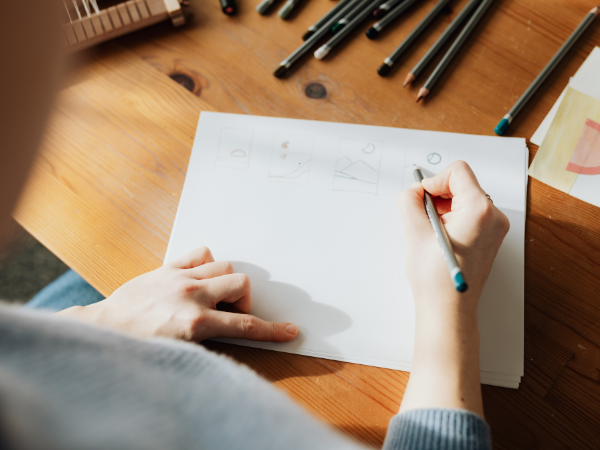Gesture drawing is one of the most fundamental practices in art education. It involves quickly sketching the human figure to capture its essence, rhythm, and energy rather than focusing on fine details. Artists use gesture drawing to train their eyes, loosen their hands, and develop a deeper understanding of anatomy and movement.
Understanding Gesture Drawing
Gesture drawing is about capturing the movement and flow of a subject in seconds. Instead of carefully rendering details, the artist focuses on the overall pose, balance, and energy.
- Speed – Drawings are often completed in 30 seconds to 2 minutes.
- Essence – The goal is to capture the “spirit” of the pose.
- Line of Action – A sweeping line that defines the body’s motion.
- Simplification – Details are omitted in favor of rhythm and proportion.
- Training – Builds confidence and sharpens observational skills.
Gesture drawing is less about perfection and more about practice. It teaches artists to see the body as a living, moving form rather than a static object.
Historical Roots of Gesture Drawing
Gesture drawing has deep historical roots, stretching back to the Renaissance. Masters like Leonardo da Vinci and Michelangelo used quick sketches to study anatomy and motion.
- Renaissance Origins – Artists sketched rapidly to understand anatomy.
- Academic Training – 18th‑ and 19th‑century art academies emphasized gesture as a foundation.
- Modern Evolution – 20th‑century artists embraced freer, expressive gestures.
- Contemporary Practice – Gesture drawing remains central in art schools worldwide.
The history of gesture drawing shows its enduring importance. It has evolved from scientific study to expressive art, but its purpose remains the same: capturing life in motion.
The Role of Gesture in Artistic Development
Gesture drawing is not just an exercise; it is a gateway to artistic growth.
- Observation – Trains the eye to see proportions and balance.
- Confidence – Reduces hesitation in line work.
- Expression – Encourages fluid, dynamic drawing styles.
- Foundation – Supports later studies in anatomy and detail.
- Creativity – Frees the artist from rigid rules.
Gesture drawing builds the foundation for all figure drawing. Without it, artists risk stiffness and lifelessness in their work.
Techniques for Effective Gesture Drawing
Artists use specific techniques to maximize the effectiveness of gesture drawing.
- Line of Action – Start with a single line that defines the pose.
- Shapes and Volumes – Use simple forms (cylinders, spheres) to block in the body.
- Exaggeration – Push the pose slightly to emphasize movement.
- Continuous Line – Avoid lifting the pencil to maintain flow.
- Timed Sessions – Practice with 30‑second, 1‑minute, and 2‑minute poses.
Technique matters, but freedom is key. Gesture drawing thrives when artists balance structure with spontaneity.
Anatomy and Gesture: Working Together
Gesture drawing is closely tied to anatomy. While gesture captures movement, anatomy ensures accuracy.
- Skeleton – Provides the framework for proportion.
- Muscles – Define tension and relaxation.
- Joints – Show flexibility and range of motion.
- Surface Landmarks – Visible points like shoulders and hips guide the sketch.
- Integration – Gesture and anatomy together create believable figures.
Gesture without anatomy risks distortion; anatomy without gesture risks stiffness. Together, they create dynamic realism.
Gesture Drawing in Different Art Forms
Gesture drawing is used across artistic disciplines.
- Fine Art – Foundation for figure painting and sculpture.
- Animation – Essential for creating fluid character movement.
- Comics – Helps design dynamic poses and action scenes.
- Fashion Illustration – Captures elegance and flow of clothing.
- Dance & Performance Art – Used to study rhythm and posture.
Gesture drawing is versatile. Its principles apply to any art form that involves movement and expression.
Practical Exercises for Gesture Drawing
Artists improve through consistent practice.
- Timed Poses – Draw figures in 30–60 seconds.
- Line of Action Studies – Focus only on the main motion line.
- Exaggeration Practice – Push poses beyond realism.
- Negative Space Drawing – Capture the space around the figure.
- Daily Sketching – Keep a sketchbook for regular practice.
Exercises build muscle memory. The more an artist practices gesture, the more natural it becomes.
The Future of Gesture Drawing
Gesture drawing continues to evolve with technology.
- Digital Tools – Tablets and apps allow timed gesture sessions.
- 3D Models – Interactive anatomy software aids practice.
- Virtual Classes – Online platforms connect artists worldwide.
- AI & Motion Capture – New tools provide dynamic references.
- Hybrid Approaches – Combining traditional and digital methods.
Gesture drawing is the art of capturing life in motion. It teaches observation, confidence, and expression. From Renaissance sketches to digital apps, it remains a vital practice for artists.




